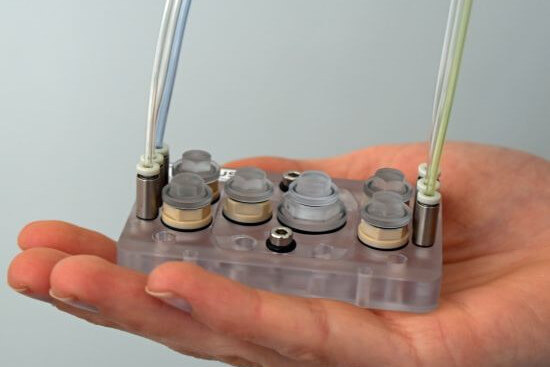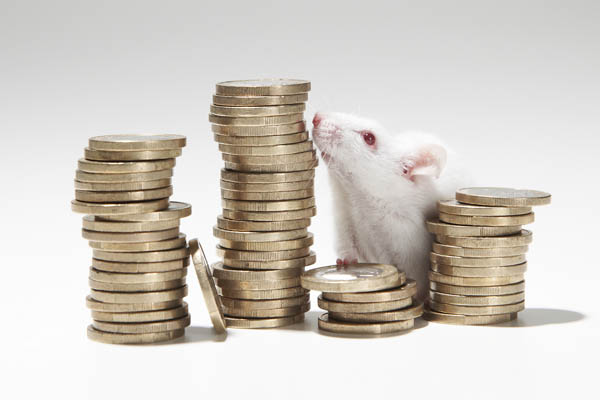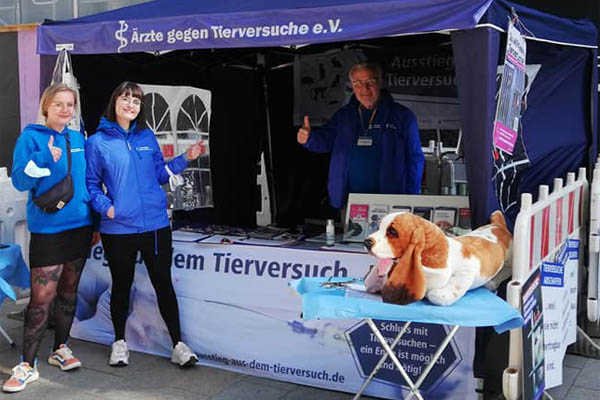Animal experiments
What are animal experiments?
According to the wording of the German Animal Welfare Act (Article 7), animal experiments are "interventions or treatments for experimental purposes on animals if they can be associated with pain, suffering, or harm to these animals".
But the Animal Welfare Act is by no means intended to protect animals from this pain, suffering, and harm. It rather serves as a basis for requirements that need to be met in order to use animals in experiments. The experiments do not serve the well-being of the animal, but aim to answer a wide variety of the researcher’s scientific questions. In other words, animals can be harmed in almost any way under the guise of the Animal Welfare Act, without there being any medical benefit.

Animal experiments are inevitably associated with pain, suffering, or harm to the animals used.
For what purpose are animal experiments conducted?
Animals are used for following purposes:
Basic research
About 56 %
Basic research has accounted for more than half of all animal experiments in Germany for years. This curiosity-driven type of research focuses on expanding the knowledge of the researcher; applicable results are not the primary goal. This domain delves into inquiries such as how primates, pigeons, or crows process images in their brains, or the reason behind hamsters losing weight during winter, involving interventions in cerebral functions. Animals are used to address even the most devious scientific inquiries, driven more by a sense of tradition than by any meaningfulness. This is due to the fact that, as proven by many scientific studies, the transferability of findings from animal experiments to humans is by no means assured.
Regulatory tests
Quality control of medical products or toxicological safety testing, approximately 17%.
In this context, chemicals, pesticides, or drugs are tested on animals for market approval. Typical tests involve daily administration of a substance by gavage directly into the stomach of mice, rats, or other animals. Depending on the substance the animals may experience respiratory distress, nausea, diarrhea, or might die. The test substance is also applied to the shaved skin of rats, mice, or rabbits, which can lead to burns and inflammation. In the case of Botox testing, each batch of the neurotoxin is injected into the abdominal cavity of mice in various dilutions to determine the dosage at which half of the animals die from respiratory paralysis ("LD50 test"). Given the significant differences in organ function and metabolism between animals and humans, the results of such experiments do not accurately predict the toxicity for humans.

Chemicals are being applied to the shaved back of guinea-pigs.
Translational and applied research
Research on diseases in humans and animals, approximately 14 %
This encompasses animal testing for drug development, where animals serve as "disease models." For decades, cancer research for example is based on mice that have been implanted with tumour cells, which is followed by attempts to cure the artificially induced illness. This procedure entails significant suffering for the animals, yet it does not yield therapies that accurately address the underlying processes in humans. A heart attack is simulated by ligating a coronary vessel in dogs or mice, while Parkinson's and diabetes are induced through the injection of toxins. Crucial aspects of causes for disease in humans, such as nutrition, stress, or lack of exercise, are not taken into account in this kind of research.
Maintenance of established colonies of genetically altered animals
approximately 8 %
Genetically modified animals now constitute approximately 45% of all animals used in experiments. In the case of mice, this figure rises to 60%. Mice are genetically altered to replicate conditions like cancer, Alzheimer's, diabetes, and other human diseases. Individual genes are deactivated or inserted to investigate their functions. Thousands of specific transgenic mouse lines exist. To maintain a constant supply of these lines, the animals are bred – a practice referred to as "maintenance".
Preservation of species
Usually under 1 %
For instance, tests are conducted to determine how fish can safely navigate through hydroelectric power plants. Also, this kind of animal experiments is unnecessary. Nowadays, "robotic fish" exist, which are capable of collecting a multitude of data as they swim through.
Animal use for higher education and training
Approximately 2,5 %
Animals are used in medicine, veterinary science, and biology studies to teach students basic biological knowledge although a broad spectrum of pedagogically superior, animal-free teaching methods exist.
Protection of the natural environment
0,5 %

Animals die in millions
According to the official statistics provided by the Federal Ministry of Food and Agriculture in Germany, almost 3 million animals are subjected to cruel and deadly experiments each year. Furthermore, so-called "surplus animals" are killed but their numbers are not disclosed in the official statistics.
Which animals suffer in animal experiments?
In essence, no species is exempt from this ordeal. According to official data, the primary victims include mice, fish, and rats. However, experiments also involve non-human primates, robins, or naked mole-rats. For instance, strokes are induced in mice by occluding a cerebral artery; fish are subjected to aging studies where they must endure hunger; epilepsy is simulated in rats through electrical shocks to the brain; monkeys are subjected to fluid deprivation and head fixation by a head post mounted on their skull; naked mole-rats are suffocated to ascertain how much longer they can live without oxygen compared to mice.

Mice are most commonly used in animal experiments.
Animal laboratories in Germany
According to our investigations, there are approximately 700 animal laboratories in 95 cities in Germany. The hotspots of animal experimentation are:
- Munich
- Berlin
- Göttingen
- Hanover
- Heidelberg
- Tübingen

Examples of animal experiments in Germany
Thousands of animal experiments having taken place in Germany are listed and described in our database on animal experiments (in German only). It shows that there is no limit to the absurdity of experimental setups.
Are animal experiments useful?
The usefulness of a method is dependent on the observer's perspective and their specific interests. From a medical-scientific standpoint, animal testing carries immense drawbacks compared to animal-free methods. Potential benefits of animal experimentation are confined to the experimenters and their academic career, and the huge industry that lives off animal experiments. Alone the failure rate of animal experiments is alarming. Up to 95% of drugs deemed safe and effective in animal testing fail during clinical trials, during which the substances are first tested on humans. Furthermore, many drugs must be withdrawn from the market due to severe side effects or death in humans, despite their apparent safety in animal experiments. Examples include the lipid-lowering drug Lipobay, the rheumatoid arthritis medication Vioxx, the heart drug Trasylol, and the multiple sclerosis drug Zinbryta.
Are there “alternatives” to animal experiments?
The term "alternatives" is put in quotation marks, as it implies that animal experimentation is a fundamentally valid method that merely requires replacement. Moreover, the term "alternative" includes both animal-free methods and those that only alleviate suffering. However, we don’t advocate for the mere modification of a flawed system, but for a complete paradigm shift — a transformation away from animal experimentation as the standard toward a modern, human-oriented research approach. Completely animal-free methods, unlike animal experiments, hold scientific value and yield results relevant to humans.
Nowadays, a multitude of animal-free research methods exists, such as multi-organ chips, epidemiological studies, and computer simulations. These methods surpass the traditional “animal testing model” not only ethically but also scientifically.
Our NAT Database lists hundreds of those modern animal-free techniques. It is possible to connect miniaturized versions of organs like intestines, livers, kidneys, hearts, lungs, skin, blood-brain barriers, or brains into a functional network on a chip, creating a miniaturized human body. The functions and metabolic processes of these mini-organs can accurately replicate those in the human body.
Through epidemiological studies (research based on human population and involving groups of people) associations between specific diseases and lifestyle factors, including nutrition and social components, can be uncovered. Epidemiological studies have identified the carcinogenic properties of tobacco smoke and asbestos, and have recognized meat- and fat-rich diets, lack of physical activity, and psychosocial factors as key contributors to diseases like diabetes, cancer, and cardiovascular disorders, including stroke, heart attack, and atherosclerosis.

Multi-organ-chips replicate a miniaturized human body.

EU regulations
With the Directive 2010/63/EU for the Protection of Animals Used in Scientific Procedures, the European Union has enacted a regulation which reflects a progressive spirit in some regards. However, there are numerous points of criticism.
The history of animal experimentation and achievements without animal suffering
The notion that medical progress is impossible without animal experiments is frequently propagated. However, the mere fact that animal experiments have a long history does not inherently grant them a positive relevance in advancing our understanding and treatment of human diseases. In fact, the opposite is true. Many pivotal medical breakthroughs have been accomplished without the use of animal experiments. For instance, aspirin was discovered in the mid-18th century through scientific ambitions, without animal testing. Animal experiments did not contribute to the success of deep brain stimulation for treating Parkinson's disease. This progress was driven by clinical research. The "MPTP monkey model", often falsely given as a pro-animal-testing example by animal researchers, was established after deep brain stimulation was already being used on patients.
Please note: The articles linked in this section are available in German only.
Funding
Despite the fact that, from a medical-scientific perspective, animal experimentation is inherently bound to fail due to methodological reasons, it continues to be funded with billions of taxpayer money every year in Germany alone. In contrast, animal-free methods receive only minuscule amounts of funding. Precise figures are not disclosed by authorities and policymakers. According to our research, animal-free research receives well below 1% of research funds, while over 99% are allocated to animal research.

Over 99 % of research funds are allocated to animal research.
Stop animal experiments!
To achieve the goal of abolishing all animal experiments, our organization, Doctors Against Animal Experiments, operates on multiple levels:
- Our work is founded on scientific investigations, setting us apart from many other associations primarily rejecting animal experiments on ethical grounds. Backed by scientifically researched data and facts, we engage with the public and policymakers.
- Convincing scientists, politicians, and citizens is a vital pillar of our efforts. We ensure that people understand that rejecting animal experiments is not solely an ethical stance but a scientifically justified one. Animal experiments impede progress in medicine due to their flawed outcomes.
- Through our political endeavours, we influence policy and legislation at local, national, and EU levels.
- Everyone can contribute to stopping animal experiments. Support our work to make our voice for the voiceless louder and stronger.

Help us to stop animal experiments for good!
